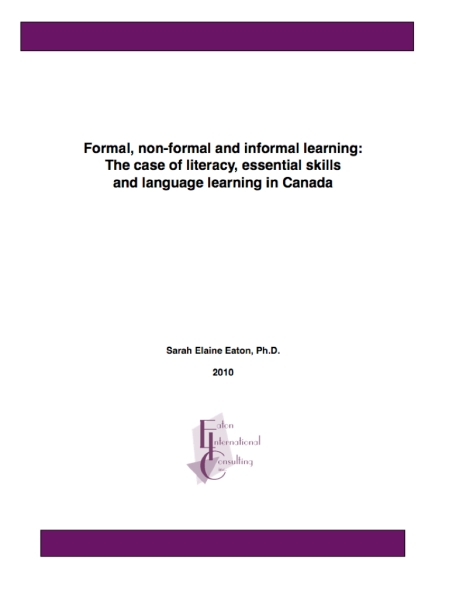This new research report is freely available in e-format (.pdf).
Executive Summary
This research report investigates the links between formal, non-formal and informal learning and the differences between them. In particular, the report aims to link these notions of learning to literacy and essential skills, as well as the learning of second and other languages in Canada.
Philosophical underpinnings of this research are:
- There is value in learning of all kinds.
- Learning is a lifelong endeavour.
- An interdisciplinary approach is valuable.
Notions of formal, non-formal and informal learning may be briefly outlined as:
Formal learning – This type of learning is intentional, organized and structured. Formal learning opportunities are usually arranged by institutions. Often this type of learning is guided by a curriculum or other type of formal program.
Non-formal learning – This type of learning may or may not be intentional or arranged by an institution, but is usually organized in some way, even if it is loosely organized. There are no formal credits granted in non-formal learning situations.
Informal learning – This type of learning is never organized. Rather than being guided by a rigid curriculum, it is often thought of experiential and spontaneous.
– (Organisation for Economic Co-operation and Development / Organisation de Coopération et de Développement Economiques (OECD), n.d.; Werquin, 2007)
Examples are given for literacy and essential skills, as well as second and other languages for each of the categories mentioned above.
Finally, the examples of systems developed value different types of learning using asset-based approaches are given. The tools developed by Human Resources and Skills Development Canada are explored for the case of literacy. The Common European Framework of Reference for Languages developed by the Council of Europe is considered for second and other languages.
Copies of the report may be accessed through:
National Adult Literacy Database (Canada)
http://library.nald.ca/research/item/8549
or
European Association of Education for Adults (Helsinki, Finland)
http://www.eaea.org/news.php?aid=17397&k=2088&%20d=2010-02
or
National Library of Canada – Online Archives Collection (Canada)
or
The Encyclopedia of Informal Education
http://www.infed.org/archives/e-texts/eaton_formal_nonformal_informal_learning.htm
or
http://globalliteracy.org/Eaton
or
Centre for Adult English Language Acquisition (CAELA) (United States)
http://www.cal.org/CALWebDB/ESLResourceDB/ (Resource #0274)
New! August, 2010 – Check out the companion report: Formal, Non-Formal and Informal Learning in the Sciences.
Related posts:
Formal, non-formal and informal education: What Are the Differences?
Formal, Non-formal and Informal Learning (Infographic) https://wp.me/pNAh3-266
Formal, Non-formal and Informal Learning: A podcast
Formal, Non-formal and Informal Learning in the Sciences
The many faces of non-formal learning
____________
If you found this post helpful, please click “Like” below and share it with others.
Here’s a link for sharing:
Formal, non-formal and informal learning: The case of literacy and language learning in Canada http://wp.me/pNAh3-C
Update – January 2018 – This blog has had over 1.8 million views thanks to readers like you. If you enjoyed this post, please “like” it or share it on social media. Thanks!
Sarah Elaine Eaton is a faculty member in the Werklund School of Education, University of Calgary, Canada.



 Posted by Sarah Elaine Eaton, Ph.D.
Posted by Sarah Elaine Eaton, Ph.D. 


You must be logged in to post a comment.